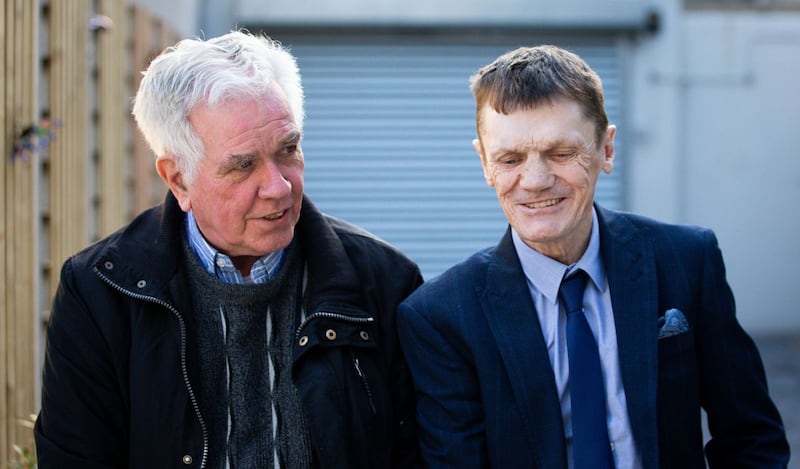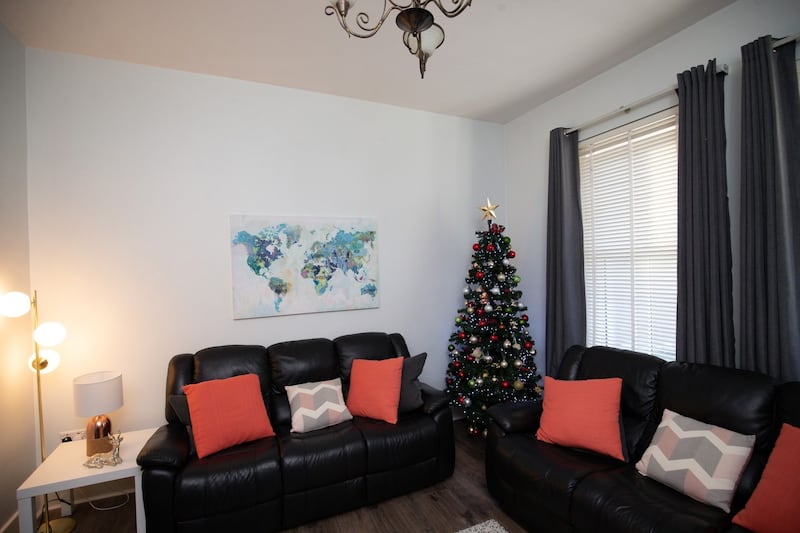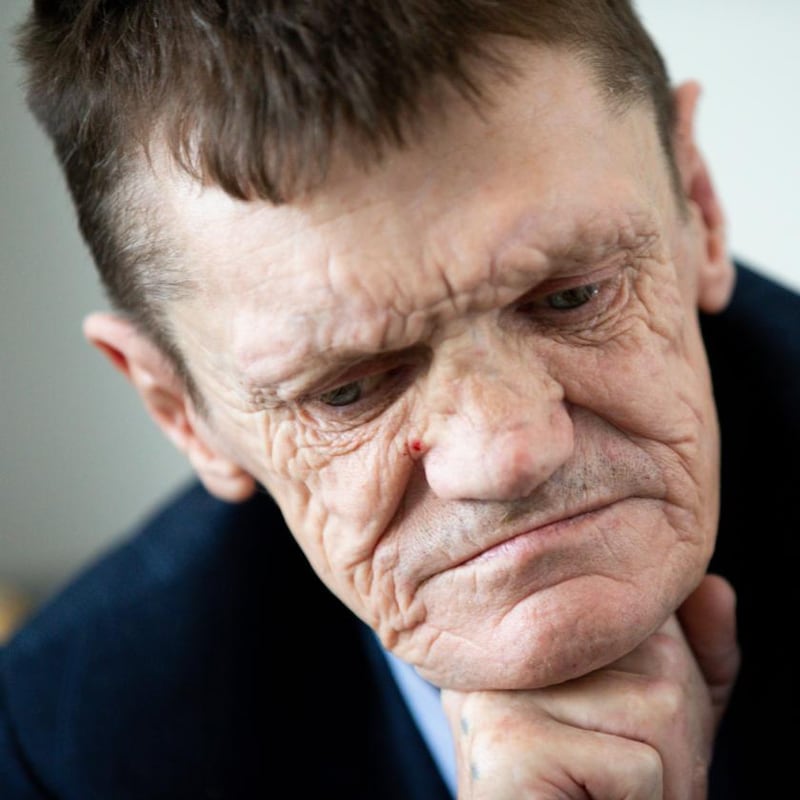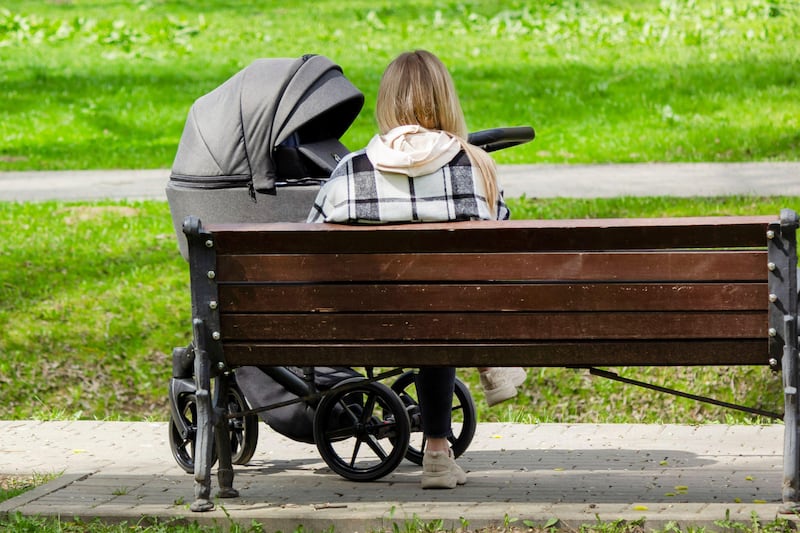When he was around 13, Paddy Fay broke into Fr Peter McVerry’s home. “Peter saw me in his bedroom and he says. ‘What are you doing?’ I said, ‘I don’t know. I’m looking for money.’ He says, ‘You can join the youth club.’ So I joined the youth club.
“He knew me from walking up and down the streets. He knew my name and knew me to say ‘Hello’ to, but we kind of built a relationship from that. One day he came to me and says, ‘Paddy, how would you like to move into a house? I’m thinking about starting a house, a place where you’d be safe.’ And I said, ‘Yeah, I could make a go of that.’ And he opened this place.”
We’re sitting in the warm family room of Tabor House, which was opened by Fr Peter McVerry for homeless teenagers 40 years ago and is still a state-of-the-art residential care home for four children between the ages of 12 and 18. There was recently a special anniversary event held here, attended by the President.

The Peter McVerry Trust now has 35 residential services and more than 400 housing units, but Tabor House was the first home he opened, and Paddy Fay is the first person he housed.
McVerry joins us accompanied by Tiny, his slightly terrifying Jack Russell (“I’d watch your hand there,” chuckles McVerry when Tiny growls at me). When I tell him Paddy’s story about breaking into his house, he laughs and says, “Which time? Many’s the time he broke into my house.”
When I mention another story Fay has just told me, about accidentally setting fire to a bus, McVerry says, “It was three buses!”
You used to see young kids getting battered by the Christian Brothers, beaten upstairs up into the showers. And whatever went on there was left to your imagination
McVerry and Fay know each other for a long time. Fay is now blind and lives in a different McVerry Trust property in Ravenswood in north Co Dublin. McVerry christened Fay’s daughter and he calls to him almost every day.
Fay is 53 and has had a tough life. He’s from a large family in Summerhill on the northside of Dublin. His parents were alcoholics and he was expected to care for his eight brothers and sisters. “My da used to beat my mother,” he says. “He used to come in drunk and beat the kids and I just packed up and left and tried to survive.”
What age was he first ran away from home? “I was 10,” he says.
Where did he go? “At first I used to stay in the blocks in Summerhill in the hallways. And you used to be able to go right down in the basement and I used to stay there.”
That must have been terrifying. “It was scary, yeah. But I thought it was better than getting a clatter every two hours or getting screamed at and told what to do and what not to do.”

As he wasn’t attending school he was eventually sent to St Joseph’s Industrial School in Clonmel, but he kept running away from there too. “There was a lot of abuse going on,” he says.
“You used to see young kids getting battered by the Christian Brothers, beaten upstairs up into the showers. And whatever went on there was left to your imagination. It wasn’t nice things that went on there. They used to clatter the head off you, and that’s why I kept running away from it.”
So he’d sleep in the corridors at the flats and in police stations and in the Summerhill bus garage. That’s where the buses went on fire. “I got into a bus one night and I was trying to get heat so I tore the back seat and lit it on fire,” says Fay. “It got too big for me to put out. It was a total accident and... I had to get out or get burned to death... when I left the bus, didn’t two other buses go on fire. So the damage was £90,000.”
It was shortly after this that McVerry encouraged Fay to start coming to the Summerhill youth club, and shortly after this again he started Tabor House, addressing a need that Fay’s plight had alerted him to.
“I was working in the inner city since 1974 and the issue was young people leaving school early; it wasn’t homelessness,” says McVerry. “They were all leaving school by the age of 12, getting into trouble and ending up in jail. So we opened a youth club called the Summerhill youth club and we opened a craft centre, a lovely craft centre…
"One of the things we made was leather belts. We'd sell them to Clerys, and the kids would want to go down and see their leather belts hanging up but security wouldn't let them in. Then I came across Paddy sleeping on the street and we said, 'We have to do something for him.'"
‘Considered suspect’
What was the nature of homelessness in Dublin then? “We just saw kids who weren’t going home, basically. They were sleeping rough or wherever they could manage to sleep… There was an issue because the mindset then was that the best place for every child under the age of 18 was in their own home. Now we know it’s the worst place for some.
“The mindset was if a young person runs away from home, call the police and bring him back home again. So we opened up this place and started taking in young people who were leaving home.”
Originally there were three bedrooms, six children and just three staff. 'We hadn't a clue how to run a residential home'
At this time McVerry’s approach was considered suspect. “I was seen as part of the problem not the solution. They saw it as encouraging young people to leave home. Then they started to fund us, but not because they saw a need for it… The inner city was starting to explode. There was a lot of car robbing and joy riding and a lot of handbag snatching along Summerhill.”
There was pressure on the government to respond to this, but all they had done, McVerry says, was to establish a juvenile prison in Cavan managed “by prison officers with two weeks childcare training.”
So there was an outcry from childcare services and when the government felt a need to respond, McVerry had three youth project proposals sitting on their desks, including one for what would become Tabor House. “Charlie Haughey told the Health Board to get those projects off the ground, purely to deflect the criticism being levelled at them... They would tell me privately not publicly, ‘Why should we spend money looking after these kids? By the time they’re 16 they’ll be in St Pat’s anyway.’”
So McVerry set up Tabor House with Vincent Bolton who ran the Belvedere Youth Club. “Between us we knew every kid in the inner city and knew the kids whose homes were just hopelessly unsatisfactory. We’d just invite the kids to come in. It was called ‘Peter’s place’ by the parents, and the parents were delighted very often because if the kids weren’t in ‘Peter’s place’ they had to go into care. Now, effectively, this was care but it was a community-based endeavour.”
‘We hadn’t a clue’
Since then Tabor House has expanded to take in the house next door. It’s a modern house with plenty of space and facilities. There’s even a self-contained flat for one older teenager preparing for life outside the care system. Originally there were three bedrooms, six children and just three staff. “We hadn’t a clue how to run a residential home,” says McVerry.

Who lived there at the beginning? McVerry struggles to remember all the names but Paddy Fay can rattle them off. Then Fay tells me about Helen Coughlin, a nurse who came to work there and would cook evening meals for them. “I’d never heard of spaghetti bolognese before that,” he says. “She lives in Wicklow. She’s 80-odd years of age and she rings me every day. I gave her an awful time when I was a kid. She’s a very nice lady.”
Why was Tabor House so important to Fay? “This was a home. It was like a family, all of us together. It was somewhere where you could go asleep and know you’d be safe and that you wouldn’t have some mad Christian brother tormenting the life out of you. You could trust the staff and you could talk to people.
“Peter taught me how to read and write… My experience of adults was nil till then. I didn’t trust adults, especially after Clonmel. I never trusted adults until I met Peter.”
The organisation that eventually became the Peter McVerry Trust grew slowly. A lot of kids, Fay included, ended up on the streets again after they left Tabor House, so with the support of Dublin City Council, McVerry opened another flat for older homeless young people. Was Fay the first person living there too? “Yeah,” says Fay.
“And the Jesuit organisation had a flat in Ballymun and the flat the corporation gave us was the flat directly over the Jesuit community flat,” says McVerry. “So guess what Paddy Fay did then?”
What? “He climbed down the balcony and robbed the flat beneath.” Fay and McVerry both laugh.
Why did he do that? “Some people call it kleptomania but it wasn’t that,” says Fay. “It was just in me.”
“It was just how you survived on the streets,” says McVerry.
Few people were this patient with troubled young men in the 1980s. Where did McVerry get that patience? He’s a bit stumped by the question. “He came from a very posh family and when he met me he had to learn about living the hard life,” says Fay.
I ask McVerry what else he learned. “I learned to keep nothing of value,” says McVerry and they both laugh again.
McVerry turned nobody away from the Ballymun flat. One night, McVerry recalls, there were 19 people sleeping there. The ad hoc nature of the organisation changed as it grew and developed. It evolved into the Arrupe Society in 1983 (after Jesuit leader Pedro Arrupe) and then it was renamed The Peter McVerry Trust in the early part of this century.
‘Homeless tsunami’
McVerry never thought he’d still be dealing with homelessness 40 years later. “I thought it was something I would do for a few years before doing something else,” he says.
He talks about how the problem has changed over the years. In the 1960s, he says, there were around 1,000 homeless people in Ireland, almost exclusively elderly men with drink problems. The problem with homeless runaways, he says, was an issue largely solved by the Child Care Act of 1991 (“It’s not perfect by any means but infinitely better than it was back in those days”).
A new group of younger homeless addicts emerged with the heroin epidemic in the 1980s. But only recently, he says, have there been large numbers of homeless families. And only recently have the official numbers of homeless people reached 10,500. McVerry thinks this is an underestimate. The real figure, he believes to be closer to 15,000.
“The official figure doesn’t count people sleeping rough or people sleeping in tents or cars,” he says. “It doesn’t count people sofa-surfing or 200 people living in the Iveagh Hostel [or] women and children in refuges who have left their home because of domestic violence. It doesn’t include around 800 refugees in direct provision who have been granted permission to stay in Ireland but can’t move out because they can’t find any where to live… If you included adults who are living involuntarily with their parents because they can’t afford to move out, and some countries do include them in the number of homeless people, it would be 100,000.”
That was the ideology – privatising everything – that has failed spectacularly. The private rental sector can't cope
And McVerry says he saw this coming. In 2011 he warned Jan O’Sullivan, then minister for housing and planning, of a coming “tsunami of homelessness”, Although he underestimated, he says. He thought it would be around 5,000 people not 10,500.
He now thinks it’s due to get worse because of the number of mortgages in serious arrears and the fact that the government incentivised international investment funds – “vulture funds” – to operate here with an array of tax exemptions.
The reasons for the increase in homelessness “are fairly clear,” he says. “In 1975 this country built 8,500 council houses. In 1985 we built 6,500 council houses. And in 2015 this country built 75 council houses. It’s the privatisation of homelessness, the privatisation of housing and this goes back 20 years.
“[The government] wanted the private sector to provide the housing and would give people a grant to pay the rent. That was the ideology – privatising everything – that has failed spectacularly. The private rental sector can’t cope. There are 50,000 households in the private rental sector under the HAP payment, and that has meant that the demand for housing in the private rental sector far exceeds supply and it has pushed up the rents. It has been spectacularly a failure but it’s still government policy.
“If you read Rebuilding Ireland, their policy is still that three out of every four people who are homeless, and three out of every four people on the social housing waiting list, will be re-housed eventually in the private rental sector…. The only solution is to go back to building council houses.”

After the coma
Paddy Fay never kept a home for long. He battled addictions to heroin and alcohol and spent his life on and off the streets, sleeping in lanes and in squats. Four years ago, he bought a bottle of what he thought was vodka and drank it. It was methanol.
“After I came out of the coma, the doctor said, ‘I have good news and bad news. Which do you want first?’ I said. ‘The good news.’ ‘The good news is you’re alive.’ I said, ‘What’s the bad news?’. He said, ‘You’re blind for life.’”
Fay no longer drinks or takes drugs and he now lives in a McVerry Trust house in Ravenswood. He has adapted. He has learned to use a stick and to move around his apartment with his hands. He visits his daughter regularly. He is here today with the assistance of a peer support worker called Jason Brogan who has also spent periods of time homeless.
Thousands of people have benefited from the Trust’s service, and McVerry often bumps into them. Some have addictions and troubled lives. Some are doing very well.
The first boy to move into Tabor House 40 years ago is now a 53-year-old man with a home, at last. “I have a lovely home,” he says, “and I go to bed every night into a warm bedroom and get under the covers and I lie awake listening to the wind and thinking, ‘How did I survive out there for so long?’”





















